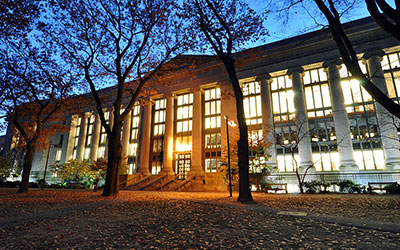
Gina Clayton, left, and Crystalee Crain prepare for an Essie Justice Group session for women with loved ones behind bars. Clayton is one of three recipients of 2014 seed grants from Harvard’s Public Service Venture Fund.
For Alec Karakatsanis and Phil Telfeyan winning cases means getting justice for clients unable to fight for themselves. Clients like the hundreds of people locked up in a Montgomery, Ala., jail because they were too poor to pay their traffic tickets.
Equal Justice Under Law, the organization founded by the two Harvard Law alums to provide pro bono legal services, filed a federal lawsuit in March arguing that Montgomery’s system of requiring people who couldn’t pay fines to sit out their debts behind bars at a rate of $50 a day was unconstitutional.
In May, a federal judge barred the city from jailing three Equal Justice clients on that ground, and Montgomery subsequently released dozens of inmates incarcerated for the same reason.
Without the seed grant that Karakatsanis and Telfeyan won from Harvard Law’s Public Service Venture Fund in 2013, some of those inmates might still be in jail. The two were the first to benefit from a program designed to help Harvard Law graduates found startups that target unmet legal needs at a time when other sources of funding were drastically reduced by a recession and years of slower economic growth.
“In my first two years as a lawyer, one of the things that really struck me the most was how significant the gap was between what we learned in law school, some of the beautiful ideals that we have, and actually how people are being treated every day in the system,” said Karakatsanis, who along with Telfeyan earned his juris doctorate in 2008. “I wanted to attack that gap and fight for the rights of impoverished people.”
Making that kind of ideal a reality requires Public Service Venture Fund grant recipients – three more of whom were announced last month as the 2014 winners – to tackle hard and often low-paying work. While the fund’s two-year seed grant of $80,000 a year includes a $45,000 stipend, that’s a fraction of the $160,000 a year a Harvard Law grad might expect to earn in an entry-level job at a large law firm.
FUTURE LEADER
“We have lots of wonderful students who are willing to forego the big salaries to work longer and take more risks about getting a job,” said Alexa Shabecoff, Harvard’s assistant dean of public service who directs the venture fund. But those students needed “a light at the end of the tunnel – a job or a way to do the work they were passionate about.”
One of the first programs of its kind at a law school, the fund awards up to $1 million a year to alums and graduating students. In addition to seed-grant winners starting their own organizations, recipients include organization-based fellows who receive $45,000 for a single year to work in a nonprofit or government agency.
Competition for the seed grants begins with applications that are due in late October, Shabecoff said. In addition to a series of essays, applicants must submit letters of recommendation and a statement from a community leader in their field verifying that there’s a need for the proposed service that’s not being met by anyone else.
A first round of interviews is conducted in November, and those who pass are assigned a coach to help fine-tune the project proposal and eliminate any potential Achilles heel before a final round of interviews in February, she said. Organization-based fellows submit their applications in March and awards are made in May.
“Because we are such a strong school on our public interest sources, we were recruiting more and more people who wanted to come here because of that,” Shabecoff said, “nurturing them while they were here, helping them, and then they were confronted with a difficult situation on the back end with no entry-level jobs.”
Creating the fund, she added, “seemed like a win-win because when we’re helping a student set up a nonprofit, for example, or helping that graduate do something he or she feels extremely passionate about, we’re cultivating a future leader in that field, and that person’s also delivering what we hope is a badly needed service.”
In the case of Equal Justice that service is assisting people living in poverty whose lack of resources might prove an impediment in the criminal system. Still, its founders recognize that there are also “civil rights violations all over, environmental violations all over where the amount of money you have will determine how seriously a court will take your claim and how seriously lawyers will jump in and help represent you,” Telfeyan said.
Equal Justice’s success will be measured in part by the systemic reform it’s able to obtain, which means winning not just easy cases but also those that have a broad effect, he said.
“We want to see that the people we’re helping are actually benefiting from what we’re doing,” Telfeyan said. “The measure in the end will be human benefit, and the great thing about the legal system is winning the case hopefully will translate to that. That depends on our continued vigilance in bringing the right cases.”
DEATH ROW
System-wide change is similarly the goal of the venture fund’s 2014 seed grant recipients: Gina Clayton, who graduated in 2010; Lam Ho, who graduated in 2008, and Mercedes Montagnes, who graduated in 2009.
Like Equal Justice, Montagnes’ Promise of Justice Initiative focuses on criminal justice issues. Based in New Orleans, the group is fighting for humane treatment of prison inmates and abolition of the death penalty in Louisiana, a state that has the highest incarceration rate in the United States. In 2010, the most recent year for which statistics are available, Louisiana had 867 incarcerated people for every 100,000 adults, more than twice the national average, according to the U.S. Justice Department’s National Institute of Corrections.
Promise of Justice “grew out of a lot of discussions that were happening within the death-penalty community about the need to have an organization that was more geared toward looking at broader structural changes and away from just direct representation,” explained Montagnes, who began doing volunteer work in New Orleans while she was in law school, after the city was devastated by Hurricane Katrina.
“One of our first initiatives was to file a lawsuit regarding the extreme heat” in Louisiana’s death-row prison cells, she said. Filed in federal court on behalf of three inmates in June 2013, the case led to research showing heat indexes at the death-row units in the Angola penitentiary regularly topped 100 degrees Fahrenheit, a level the National Weather Service warns may cause increasingly severe heat disorders, according to court records.
Chief U.S. District Judge Brian Jackson of the Middle District of Louisiana subsequently found the conditions violated inmates’ constitutional protection from “cruel and unusual punishment” and ordered the state correction department to come up with a plan for keeping the heat index at 88 degrees or below.
The state appealed to the 5th U.S. Circuit Court of Appeals shortly afterward, arguing that the conditions at Angola weren’t inhumane and that the judge overstepped his bounds with an order that would basically require the units to be air-conditioned while giving the state no latitude for the limited funding available for its prison system. That case is pending.
The potentially broad effects of Judge Jackson’s ruling, if upheld, reflect the Promise of Justice Initiative’s mission of working for structural change rather than focusing on direct representation, which might help only a few people at a time. Winning the Harvard seed grant allowed Montagnes to ease her focus on immediate needs and think strategically about the organization’s mission and how best to develop its resources.
“We’re lucky in the sense that we have achieved certain things already, and so that buys us a bit more credibility as we move forward,” she said. “That actually is a huge strategic advantage because we’re not creating something out of nothing, and in the criminal justice community, folks know the work that we’ve been able to do thus far, and they’re happy with that work.”
LIFE ON THE OUTSIDE
Prisons are also pivotal to the work of the Essie Justice Group, the San Francisco-based organization founded by Clayton. Its focus, however, is on relatives on the outside, rather than on inmates themselves, and how they cope with the personal loss, social shame and, frequently, reduced income. It’s named for Clayton’s great-grandmother, Essie Bailey, the daughter of Louisiana sharecroppers, who moved to the West Coast, where she raised three children while working three jobs.
Once Clayton began delving into family lore to find out just how her great-grandmother pulled that off, she learned Bailey had relied on female relatives who lived nearby.
“There was this literal sisterhood of women,” Clayton said in an interview. They gave her the strength “to not just survive amid all these kinds of difficulties, poverty and childbearing and doing all that alone, but also thrive eventually. She ended up doing very well.”
That sisterhood is the premise on which Essie Justice Group is built.
The organization plans to bring together groups of women who have sons, husbands and other male relatives in prison for a nine-week program that zeroes in on trauma healing, managing money in times of crisis and leadership development.
“The curriculum is designed to give the reins over to the women in the group themselves, so that they’re not just participants but they become full partners in the work,” Clayton said. Because it’s replicable, it will “allow us to seed many, many, many groups across the country over time.”
One of the things Clayton learned during the pilot group’s first meeting, in late September, was just how much the women wanted a safe haven to discuss their experiences.
“There was this desperate need for a place where women could heal and talk about what was going on in their families and their lives,” she said. “Striving to be the provider, the caretaker, the moral standard-bearer of families is very, very difficult in those circumstances, and not having any place to talk about what that’s doing to them emotionally, and their ability to be strong, was really apparent.”
Managing money wisely becomes even more important when a loved one is locked up because not only is there typically less income, there’s an emotional impetus to spend what is available on the inmate, she explained.
“The calls, ‘Mama, could you put just a little bit more money on my commissary account so I can buy food in here,’ those things are happening regularly to women who feel that there’s nothing that the system allows for them to be or do, that they are rendered completely hopeless,” Clayton said. “So when you get that call for money, you give the landlord’s money to the incarcerated person because you’re ‘Mom,’ and you’re in pain with the person who is suffering behind bars.”
While Essie Justice will eventually take on wide-scale advocacy, its focus for now is on building its base and forming communities. Then, as members heal and grow stronger, they’ll have a voice in deciding what issues to tackle, Clayton said.
“I went to law school, really, to do this,” she said. “It seems confusing to some people who feel like what being a lawyer means is to be in court every day or at a law firm. To me, it’s never meant that. It’s meant being an advocate, and I feel like that’s what I get to be in the way that I know how. What I love about the venture fund and this opportunity is that it allows lawyers with nontraditional skill sets to be able to pursue their passions and their ideas for social change in a really big way.”
COMMUNITY ACTIVISM & LAW
Clayton’s characterization of the fund echoes that of Lam Ho, who struggled unsuccessfully to raise money for a community lawyering project in Chicago in 2011. It was a time when large law firms had begun laying off staff as their clients cut costs amid a slower economy.
Ho had already worked in neighborhood offices of the Legal Assistance Foundation on the west and south sides of Chicago, the city’s poorest areas. He wanted to start an organization that would not only bring legal services to the neighborhoods of people in need but would also team with other groups to push for broader systemic change.
“I struggled to find the funding to do this,” he said. “And out of the blue, Harvard comes up with this absolutely amazing, perfect, overwhelmingly fantastic opportunity.”
The seed grant Ho won this year enabled him to set up the Community Activism Lawyering Alliance, which will provide legal clinics in cooperation with partners including the Immigrant Youth Justice League and Organized Communities Against Deportation, the Sex Workers Outreach Project and Enlace Chicago, a group that works with residents of the Little Village neighborhood.
The clinics will generally be held every week, and the first, with Immigrant Youth Justice, will open at the end of this month with two sessions a week. Clients will meet with a CALA attorney as well as an advocate from the partner group and receive services from on-site advice to full representation, Ho said.
“We’re going to be providing the legal representation on removal proceedings for undocumented immigrants,” he said. “But we’re not going to be just filing cases. Instead we’re giving them opportunities to hold rallies. We’re giving them opportunities to form coalitions around these cases. One big difference, for example, is that we’ll be taking cases through the clinic that I know we’re going to lose.”
While lawyers generally eschew cases in which the weight of the law is all on the opponent’s side, the strategy will draw attention to “some of the absurdity and some of the things that need to be changed in the law,” Ho said. “So the cases and the work that we do is really tied into the activism side of it.”
Equally important is the model itself. Combining legal aid and activism helps make up for declining government funding for legal services for the poor, Ho said. A 2013 report by the Kresge Foundation and the Public Welfare Foundation showed financing has dwindled even as the number of low-income people in need of legal services swelled 22 percent to 61 million in the roughly two decades through 2012.
“One of the reasons this model is important is not only in terms of the social impact and social change that it can provide, it’s also a more economically efficient model,” he said. “You don’t need to take expensive real estate to run and really provide great legal services to people who need it. You can provide it to people who need it in their neighborhoods and make it more accessible and do it a lower rate as well.”
Enabling high-quality legal assistance to people who need it but lack the resources to pay is at the heart of the venture fund’s mission, Harvard’s Shabecoff said.
“The number of people living in poverty has gone up, but the funding has not,” she said. “This seemed like a way to close the justice gap while also helping our remarkable students and graduates.”
While the seed grant provides financial stability for fledgling organizations, allowing the founders a window in which to begin carrying out their strategy without worrying about the next month’s light bill, it also gives a measure of credibility for potential donors in the future.
“The biggest difficulty with starting a new organization is finding that first big funder who will believe in you,” Ho said. “It always gets so much easier once you get that first big donation.”
Contact James Langford at (646) 722-2624 or james@lawdragon.com.




